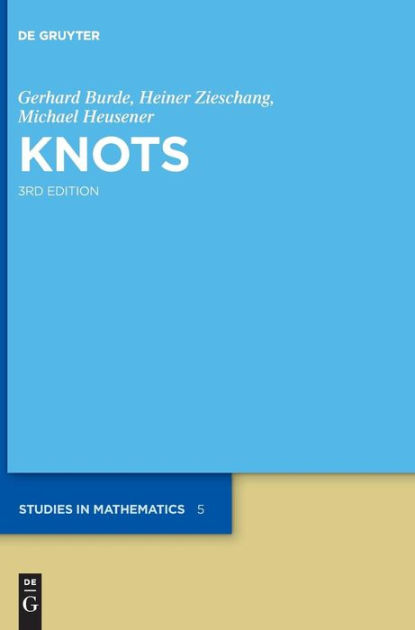Copies of the classnotes are on the internet in PDF format as given below. The "Proofs of Theorems" files were prepared in Beamer. The "Printout of Proofs" are printable PDF files of the Beamer slides without the pauses. These notes and supplements have not been classroom tested (and so may have some typographical errors).
ETSU does not have a formal graduate class on knot theory.
I have Introduction to Knot Theory notes based on Charles Livingston's Knot Theory, The Carus Mathematical Monographs, Volume 24 (MAA, 1993).
Chapter 1. Knots and Isotopies.
- Section 1.A. Knots.
- Section 1.B. Equivalence of Knots.
- Section 1.C. Knot Projections.
- Section 1.D. Global Geometric Properties.
- Section 1.E. History and Sources.
- Section 1.F. Exercises.
- Study Guide 1.
Chapter 2. Geometric Concepts.
- Section 2.A. Geometric Properties of Projections.
- Section 2.B. Seifert Surfaces and Genus.
- Section 2.C. Companion Knots and Product Knots.
- Section 2.D. Braids, Bridges, Plats.
- Section 2.E. Slice Knots and Algebraic Knots.
- Section 2.F. History and Sources.
- Section 2.G. Exercises.
- Study Guide 2.
Chapter 3. Knot Groups.
- Section 3.A. Homology.
- Section 3.B. Wirtinger Presentation.
- Section 3.C. Peripheral System.
- Section 3.D. Knots on Handlebodies.
- Section 3.E. Torus Knots.
- Section 3.F. Asphericity of the Knot Complement.
- Section 3.G. History and Sources.
- Section 3.H. Exercises.
- Study Guide 3.
Chapter 4. Commutator Subgroup of a Knot Group.
- Section 4.A. Construction of Cyclic Coverings.
- Section 4.B. Structure of the Commutator Subgroup.
- Section 4.C. A Lemma of Brown and Crowell.
- Section 4.D. Examples and Applications.
- Section 4.E. Commutator Subgroups of Satellites.
- Section 4.F. History and Sources.
- Section 4.G. Exercises.
- Study Guide 4.
Chapter 5. Seifert Matrices. START EDITING HERE.
- Section 5.1. The Seifert Surface.
- Section 5.2. The Genus of a Knot.
- Section 5.3. The Seifert Matrix.
- Section 5.4. S-Equivalence of Seifert Matrices.
- Study Guide 5.
Chapter 6. Invariants from the Seifert Matrix.
- Section 6.1. The Alexander Polynomial.
- Section 6.2. The Alexander-Conway Polynomial.
- Section 6.3. Basic Properties of the Alexander Polynomial.
- Section 6.4. The Signature of a Knot.
- Study Guide 6.
Chapter 7. Torus Knots.
- Section 7.1. Torus Knots.
- Section 7.2. The Classification of Torus Knots (I).
- Section 7.3. The Seifert Matrix of a Torus Knot.
- Section 7.4. The Classification of Torus Knots (II).
- Section 7.5. Invariants of Torus Knots.
- Study Guide 7.
Chapter 8. Creating Manifolds from Knots.
- Section 8.1. Dehn Surgery.
- Section 8.2. Covering Spaces.
- Section 8.3. The Cyclis Covering Space of a Knot.
- Section 8.4. A Theorem of Alexander.
- Study Guide 8.
Chapter 9. Tangles and 2-Bridge Knots.
- Section 9.1. Tangles.
- Section 9.2. Trivial Tangles (Rational Tangles).
- Section 9.3. 2-Bridge Knots (Rational Knots).
- Section 9.4. Oriented 2-Bridge Knots.
- Study Guide 9.
Chapter 10. The Theory of Braids.
- Section 10.1. Braids
- Section 10.2. The Braid Group.
- Section 10.3. Knots and Braids.
- Section 10.4. The Braid Index.
- Study Guide 10.
Chapter 11. The Jones Revolution.
- Section 11.1. The Jones Polynomial.
- Section 11.2. The Basic Characteristics of the Jones Polynomial.
- Section 11.3. The Skein Invariants.
- Section 11.4. The Kauffman Polynomial.
- Section 11.5. The Skein Polynomials and Classical Knot Invariants. (Alternating Knots and the Tait Conjectures).
- Study Guide 11.
Chapter 12. Knots via Statistical Mechanics.
- Section 12.1. The 6-Vertex Model.
- Section 12.2. The Partiion Function for Braids.
- Section 12.3. An Invariant of Knots.
- Study Guide 12.
Chapter 13. Knot Theory in Molecular Biology.
- Section 13.1. DNA and Knots.
- Section 13.2. Site-Specific Recombination.
- Section 13.3. A Model for Site-Specific Recombination.
- Section 13.4. Recombination due to the Recombinase Tn3 Resolvase.
- Study Guide 13.
Chapter 14. Graph Theory Applied to Chemistry.
- Section 14.1. An Invariant of Graphs: The Chromatic Polynomial.
- Section 14.2. Bing's Conjecture and Spatial Graphs.
- Section 14.3. The Chirality of Spatial Graphs.
- Study Guide 14.
Chapter 15. Vassiliev Invariants.
- Section 15.1. Singular Knots.
- Section 15.2. Vassiliev Invariants.
- Section 15.3. Some Examples of Vassiliev Invariants.
- Section 15.4. Chord Diagrams.
- Section 15.5. Final Remarks.
- Study Guide 15.
Appendix.
- Appendix I. A Table of Knots.
- Appendix II. Alexander and Jones Polynomials.
Return to
Bob Gardner's home page

